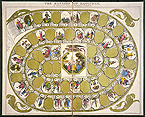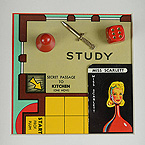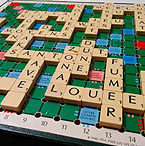









How The Board Game Was Won
Board games occupy an important place in almost every culture, having been a part of social interaction from some of the earliest civilisations. Their role has extended beyond organised play to reflect concerns of different societies and until recently there can have been few houses that did not possess at least one or two games, writes Jane Clothier.
With board games now mostly pursued as a leisure activity it's fascinating to consider their long, rich and varied history, which reveals more significant associations.
Death and the board game
Picture, if you will, a scene some 5000 years ago in Bronze Age Turkey. A small group of people are sitting together, playing with a handful of small, carved painted stones. This information comes to us via archaeological findings from 2013, when excavations of a burial site in southeast Turkey revealed 49 sculpted pieces said to have been used in board games. The carved shapes include pigs, dogs, pyramids and bullet shapes.
As the oldest such pieces ever found, this collection firmly places the origin of board games in Syria, Iraq and Turkey, in a region known as the 'Fertile Crescent' (or 'cradle of civilisation'). In Egypt, predynastic and First Dynasty burials have shown us that board games were popular with the Pharaohs. Uppermost was the game of Senet, which by 1550-1077 BC was considered an essential item for the journey of the deceased. It was apparently believed that a successful game player would have heightened odds when it came to a successful passage, especially under the protection of the major gods of Ra, Thoth and Osiris. Senet is even mentioned in The Book of the Dead. The rules of Senet are lost in time, although historians have attempted to resurrect them and some games companies have reproduced the game with various interpretations of the rules.
Senet may have been the game of the Pharaohs but, as in many societies, the working man had other preferences and games such as Mehen gained widespread popularity in Egypt. The religious connection was still present: Mehen was a deity who took the form of a serpent and was worshipped by the Sun Cult. The game replicates the belief that this huge serpent wrapped itself about the Sun God Re. Eventually, the game and the belief system became so entwined that it is no longer clear which came first. As with Senet, the rules of Mehen are no longer known. However, there is a similar Arabian game called Hyena, and it is generally accepted that the rules are interchangeable. In Hyena, each player moves marbles along a snake's form to the outer edge of the board. Moving pieces along snakes on a board - does that sound familiar?
Gaming on with backgammon
Another tomb artifact is the Royal Game of Ur, one of the oldest complete board games ever discovered. Pre-2600 BC, two boards of the game, also known as the Game of Twenty Squares, were buried in Iraq's Royal Tombs of Ur. The rules for this game were found carved into an ancient stone tablet by game enthusiast Irving Finkel, who matched these with the pieces of an identical board game photographed in modern India. Remarkably, this was the precursor of a game still played today: backgammon.
Earlier adopters of backgammon were the Romans, who included it in numerous European frescoes, with players sometimes shown scantily clad. Clearly, by this point, the game carried little religious significance and was associated with a level of debauchery. Emperor Claudius was reputed to have been a keen player, while Emperor Nero fully embraced the gambling aspects, playing for pots equivalent to US$10,000 per game.
Backgammon also travelled from the Middle East with the Crusaders. Large stakes were wagered amongst their officers, while regular soldiers were forbidden to play, presumably due to disruption caused by anguished losers. Backgammon remained popular in Europe for the next 500 years, despite attempts by authorities and the church to ban it.
In the last century, the game's appeal started to wane. However, necessity is the mother of invention and in the 1920s an unidentified American gambling innovator introduced the idea of doubling the stakes. Around that time, a multiple player version of the game was introduced. With doubled stakes and more players, the game took on a new lease of life. Its popularity was firmly restored in the mid-1960s, with the formation of the International Backgammon Association complete with revised official rules, international tournaments and even a World Championship.
King of the board games
It is often said that an early Persian form of backgammon influenced the development of chess, known in that country as Shatranj. However, this was only developed in the 7th century, for its true beginnings were in an ancient Germanic and Celtic strategy board game called Tafl, which was played on a chequered board with two armies. The Vikings were responsible for Tafl's spread across Northern Europe, from where it eventually travelled to India, where it was transformed into the strategy game of Chaturanga. Only then did it travel to Persia. This was the game that was then re-introduced to late-medieval Europe, and which in Germany became known as Schach. By around 1475, the game was known as chess and its rules were becoming recognisable as the modern game.
The history of chess will be covered in more depth in a forthcoming issue.
Games of instruction
With the rise of mass production, American as well as European game publishers began to appear, as did a new kind of professional: the games designer. One early American publisher was W & SB Ives, formed in 1830. In 1843, the company published Mansion of Happiness, which was promoted as 'An instructive and entertaining amusement'. The original game had been designed in the late 1700s by George Fox, an English children's author and game designer, and produced in small numbers. In this game, the virtuous player was entitled to advance towards the Mansion of Happiness, while the sinful player was destined instead for the stocks or whipping post. Despite this somewhat austere premise, the game became popular and was modernised by the new publisher Parker Brothers in 1894.
In 1904, American game designer Lizzie Magie aimed to continue the trend for moral instruction with a new game. Inspired by urbanisation and capitalist acquisition of properties, it was originally known as The Landlord's Game. Lizzie Magie aimed to demonstrate how property owners could profit at the expense of their tenants, her overarching hope being that those playing The Landlord's Game would become of aware of unfair practices and avoid becoming victim to unscrupulous profiteers.
Once it was purchased by Parker Brothers in 1935, the game was marketed as Monopoly. Whether Lizzie Magie achieved her original goal is uncertain, for the enjoyment of the game continues to be banking the largest takings of paper money. Monopoly is sold in 111 countries and is played in 43 languages. The longest Monopoly game in in history lasted for 70 straight days and the most expensive version ever made has been valued at $2m. It features a 23ct gold board and diamond-studded dice and was made by San Francisco jeweller Sidney Mobell.
A simple but winning concept
A low concept game that needs little to no introduction is Snakes and Ladders. First published in England in 1892, it is said to owe much to an Indian game, Moksha, dating from around 200BC. This was an allegory of ascent to destiny and spiritual liberation via ladders, but regression via snakes due to karma or desire. The British adaptation was somewhat kinder to its players' chances, with an equal quota of snakes and ladders. Nevertheless, the Victorians saw an opportunity for moral instruction, so adapted these to the effects of good and bad deeds, virtue and vice. This morality was softened slightly in Milton Bradley's 1943 US version, Chutes and Ladders, with children climbing with good deeds and descending chutes for mischievous actions.
An intelligent pastime
In 1948, an unemployed American architect called Alfred Mosher Butts invented a game that went on to sell over 100 million sets worldwide. This board game was based on Butts' analysis of other successful games, which showed him that certain characteristics were essential: numbers, moving pieces, and words, combined with chance and player skills, and also with aspects of the crossword and anagram. Nothing if not a researcher, Butts also studied the front page of The New York Times to quantify how frequently letters appeared. The result was a game called Criss Cross Words. Astonishingly, his invention was rejected by all major games manufacturers, only to be taken up by another entrepreneur, James Brunot. After refining the rules, the pair finally released the Scrabble Brand Crossword Game, having stamped letters onto wooden tiles by hand.
Production was small scale at first, with the game initially achieving a cult-like status. In the early 1950s the president of Macy's chanced up on it and the rest, as they say, is history. Word filtered out in the press and media, and Scrabble became the 'must have' game. Some 70 years later, Butts' word game is unchanged and is to be found in millions of homes.
A game of deduction
In 1943, Anthony E. Pratt, a solicitor's clerk from Birmingham, England, devised a new game called Cluedo, which reflected the popularity of English crime novels by writers such as Agatha Christie. Elva Pratt, his wife, designed the board. Although Waddington's Games accepted the game in 1944, it was not produced until 1947 due to post-war production issues. Once released to the public in 1949, it became an instant hit.
The game concept is the detection of a murder location and weapon, and of course the murderer. The board shows the layout of an English country house called Tudor Mansion (Boddy Manor or Mansion in the US), which is the scene for a murder. Coloured playing pieces represent the characters, while the other contents are miniature murder weapon props, dice, solutions cards and a notebook.
In 1949, Parker Brothers bought the US rights and published the game in the US as Clue. It was originally marketed as 'The Great New Detective Game' and then as 'The Great New Sherlock Holmes Game'. In its time, Cluedo has inspired a movie, Clue (1985), a miniseries of the same name, video games, computer games, a musical, a play, jigsaw puzzles and many books. There have been numerous spin-offs with changes to the rules, and variants which feature the same rules. In 2008, Hasbro (who bought both Waddingtons and Parker Brothers in 1991) revamped the game. Today, it is possible to buy Cluedo 'the Classic Mystery Game', as well as surprising variants such as the Game of Thrones edition.
A game of strategy
In 1957, the game of Risk was created by French movie director Albert Lamorisse in 1957. The game was originally marketed under the name La Conquête du Monde (The Conquest of the World), which gives an idea of its central premise: to achieve domination by eliminating opponents.
The original board was a map divided into 42 territories on six continents, and the pieces were rectangular wood cubes. Players control armies of playing pieces and must attempt to capture territories from other players. As diplomacy is part of this game, players can form and abandon alliances. These complex relationships account for why Risk can take between a few hours to several days to complete.
French game publisher Miro originally bought and published the game. Parker Brothers published the US version and made a few changes, marketing it as Risk: the Continental Game. Variants were produced, including the failed 1986 Castle Risk, which featured a map of 18th century European castles instead of continents. The more successful Risk: Édition Napoléon was issued in 1999 to commemorate the bicentenary of the Napoleonic era, and an intergalactic edition called Risk: 2210 AD, was issued in 2001. Risk now ranks as one of the most popular board games ever, and today is available not just as a board game but as computer, video and mobile app games.
Survival or extinction?
Contemporary supporters of board games will point to them as integral to a more social period, when people relied less on the digital screen to communicate with one another. Competition from online games has forced the attempted adaption of established games to software editions, but this has not been wholly successful. Meanwhile, new board games continue to appear, but it is doubtful they will ever reach the same heights of international popularity. Only rich traditions and the continued success of the most enduring games can support the survival of games that date back as far as civilisation itself.
This feature first appeared in the Winter 2017 edition of Antiques and Collectables for Pleasure & Profit.